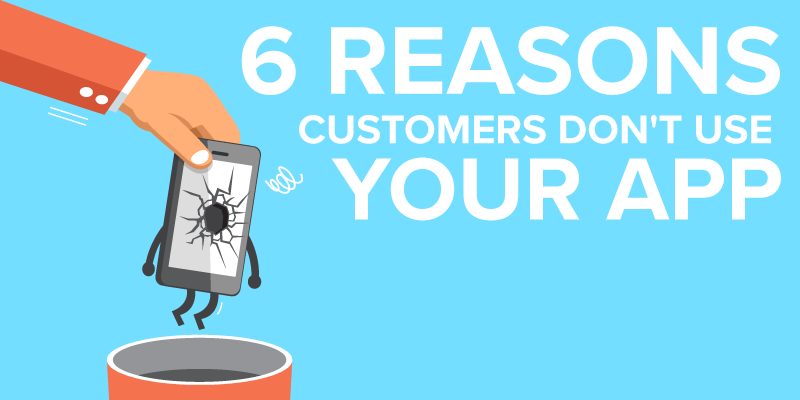6 Reasons Customers Don’t Use Your App
Creating an app for your business is perhaps one of the most important decisions that you will take. Not only will it help in creating an image of your brand, it will also become the prime factor in the way potential and existing customers engage with your business.
This decision is all too important and also a little daunting. Businesses are afraid that they might fail to get the desired results from their apps, especially because the development of a well-designed app can cost upwards of thousands of dollars.
But, I would like to make it easier for those of you who plan to take the plunge and take their businesses to the next level. Here are some of the common reasons why some businesses fail to create apps that users love.
Reason #1: You are serving the wrong audience
The importance of presenting your app to the right audience cannot be stressed enough. First, giving your app to the wrong people will never result in any meaningful number of downloads. The few downloads that do happen, won’t be much help. Soon, your app will be forgotten, leaving you to wonder what went wrong.
This is why it is extremely important – so much so that your success depends on it – that you present your app to people who will download it, use it on a regular basis and remember you for what you offer. This is the only way to secure high retention rates.
Reason #2: Your app fails to meet your customers’ needs
How do you know that your app solves a problem, or provides an answer to what your customers need? How would you develop an app that perfectly serves the need of your target audience?
Like any new addition or upgrade in a business, you will have to study, observe, understand and talk to your customers – ideally even before you start designing your app.
Find out what your customers are looking for, what will keep them happy and coming back for more? Is it rewards, discounts, freebies, entertainment, exclusive insider news, or something else?
Also, avoid the most common pitfall of duplicating your website for mobile devices. The requirements of mobile users are much different than that of desktop users. Make sure to keep that in mind before you go ahead.
Reason #3: Your app is ‘no style, no substance’
Onboarding is the first and the most important opportunity that you get to draw a user in. Simplicity is key as you develop your app. This is an additional reason for users to get hooked. Give careful thought to the purpose of each design element you’d like to add to your app, even as basic as your logo or menus.
Make sure design follows function.
In order to gather information about the user that isn’t exactly necessary for proceeding to the next step, some experts suggest giving a bait, like an ebook or exclusive resource which will open up only when the user adds his email address and other required information. On the other hand, allowing users one-touch functionality to log in by connecting their social media profiles is also a good idea.
Onboarding can be most useful for apps that require some explaining, for example, gesture-driven apps. The process of onboarding can also help highlight the app’s biggest benefits and explain how it can help improve users’ life.
Reason #4: There is no gamification
Gamification might sound like some fun, but it is much more than that. Some experts even link it to human psychology and more exactly, Maslow’s Hierarchy of
Needs where gamification can result in emotions of belonging, self-esteem, safety and actualization.
On the other hand, it should also be remembered that no amount of gamification will bring disinterested users to your app. No technique will work on people who just aren’t interested in what you have to say.
Such techniques will help retain interested users by keeping them motivated. Rewards like collectables, badges or placing on a leaderboard can be added. Access to some exclusive features like discounts, themes and characters can be unlocked based on gaming scores and progression, and this will result in the increase of the value and growth of the app.
Additionally, remember to link the rewards to the purpose of the app. For example, are you trying to improve user engagement, user acquisition or user loyalty?
The rewards will vary according to your objective.
Reason #5: You didn’t build virality into your app
When users or customers share the word with their peers, it’s priceless. The result is 100% authentic brand ambassadorship which is bound to bring exceptional results in both the short and the long term.
Today, it’s not enough to slap a few sharing buttons at the end of your app and think your job is done. Think about what will motivate your users to spread the word with their friends?
Apps like RunKeeper do it well. Users like to share ‘vanity content’ to show off how hard and intense they work out. Sharing such content with peers makes people feel good about themselves. PayPal used virility paying people who referred their friends to use its services.
Dropbox provided extra space to both the referrers and the referees. You too can offer these and similar other rewards to your users, multiple times during their app journey.
Make it very easy for users to share content and information in your app with friends on social media. You could create an app which allows users to grow their network in-app, both to your and the user’s benefit.
Reason #6: There is no post-launch communication strategy
Creating a good app means communicating with the user frequently. An app cannot be downloaded to sit dormant on a mobile device – otherwise, it will lose its value to the user.
The post-launch communication strategy is the most important part of the process of engaging and retaining customers. Most businesses design really innovative, brilliant apps and then just stop at that.
Ask yourself these essential questions; how do your customers like to be communicated with? What motivates them to buy? What would be the best way to keep them engaged with the app?
Then design a communication strategy which meets their needs, and your business goals. Plan to touch every customer at least once a month.
You can use any of the following; text messages, freebies, discounts, coupons, deals, special sale offers, alerts and push notifications to achieve this end.
Final words
If you are lacking in one or more of the above-mentioned areas, then improve your strategy. Once you are able to recognise the problem areas, there will be endless methods that will help you boost retention and decrease customer churn.
____
Ian Naylor is the Founder & CEO of AppInstitute, a DIY app builder platform for small businesses. He’s responsible for strategy, business development and product leadership.








